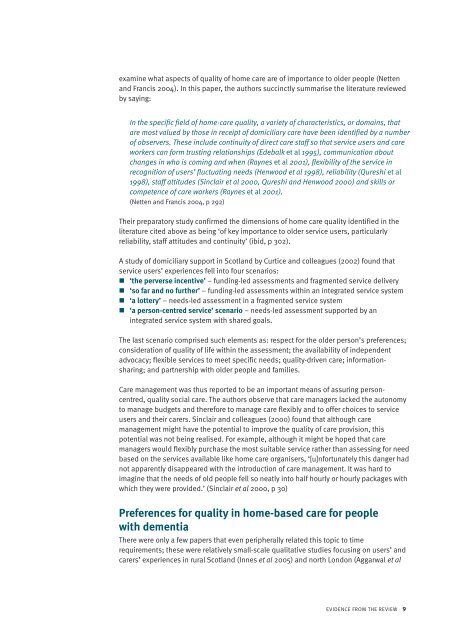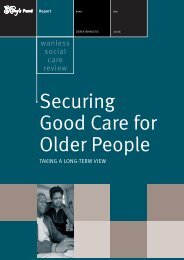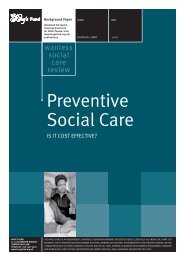Time and other inputs for high quality social care - The King's Fund
Time and other inputs for high quality social care - The King's Fund
Time and other inputs for high quality social care - The King's Fund
Create successful ePaper yourself
Turn your PDF publications into a flip-book with our unique Google optimized e-Paper software.
examine what aspects of <strong>quality</strong> of home <strong>care</strong> are of importance to older people (Netten<br />
<strong>and</strong> Francis 2004). In this paper, the authors succinctly summarise the literature reviewed<br />
by saying:<br />
In the specific field of home-<strong>care</strong> <strong>quality</strong>, a variety of characteristics, or domains, that<br />
are most valued by those in receipt of domiciliary <strong>care</strong> have been identified by a number<br />
of observers. <strong>The</strong>se include continuity of direct <strong>care</strong> staff so that service users <strong>and</strong> <strong>care</strong><br />
workers can <strong>for</strong>m trusting relationships (Edebalk et al 1995), communication about<br />
changes in who is coming <strong>and</strong> when (Raynes et al 2001), flexibility of the service in<br />
recognition of users’ fluctuating needs (Henwood et al 1998), reliability (Qureshi et al<br />
1998), staff attitudes (Sinclair et al 2000, Qureshi <strong>and</strong> Henwood 2000) <strong>and</strong> skills or<br />
competence of <strong>care</strong> workers (Raynes et al 2001).<br />
(Netten <strong>and</strong> Francis 2004, p 292)<br />
<strong>The</strong>ir preparatory study confirmed the dimensions of home <strong>care</strong> <strong>quality</strong> identified in the<br />
literature cited above as being ‘of key importance to older service users, particularly<br />
reliability, staff attitudes <strong>and</strong> continuity’ (ibid, p 302).<br />
A study of domiciliary support in Scotl<strong>and</strong> by Curtice <strong>and</strong> colleagues (2002) found that<br />
service users’ experiences fell into four scenarios:<br />
• ‘the perverse incentive’ – funding-led assessments <strong>and</strong> fragmented service delivery<br />
• ‘so far <strong>and</strong> no further’ – funding-led assessments within an integrated service system<br />
• ‘a lottery’ – needs-led assessment in a fragmented service system<br />
• ‘a person-centred service’ scenario – needs-led assessment supported by an<br />
integrated service system with shared goals.<br />
<strong>The</strong> last scenario comprised such elements as: respect <strong>for</strong> the older person’s preferences;<br />
consideration of <strong>quality</strong> of life within the assessment; the availability of independent<br />
advocacy; flexible services to meet specific needs; <strong>quality</strong>-driven <strong>care</strong>; in<strong>for</strong>mationsharing;<br />
<strong>and</strong> partnership with older people <strong>and</strong> families.<br />
Care management was thus reported to be an important means of assuring personcentred,<br />
<strong>quality</strong> <strong>social</strong> <strong>care</strong>. <strong>The</strong> authors observe that <strong>care</strong> managers lacked the autonomy<br />
to manage budgets <strong>and</strong> there<strong>for</strong>e to manage <strong>care</strong> flexibly <strong>and</strong> to offer choices to service<br />
users <strong>and</strong> their <strong>care</strong>rs. Sinclair <strong>and</strong> colleagues (2000) found that although <strong>care</strong><br />
management might have the potential to improve the <strong>quality</strong> of <strong>care</strong> provision, this<br />
potential was not being realised. For example, although it might be hoped that <strong>care</strong><br />
managers would flexibly purchase the most suitable service rather than assessing <strong>for</strong> need<br />
based on the services available like home <strong>care</strong> organisers, ‘[u]n<strong>for</strong>tunately this danger had<br />
not apparently disappeared with the introduction of <strong>care</strong> management. It was hard to<br />
imagine that the needs of old people fell so neatly into half hourly or hourly packages with<br />
which they were provided.’ (Sinclair et al 2000, p 30)<br />
Preferences <strong>for</strong> <strong>quality</strong> in home-based <strong>care</strong> <strong>for</strong> people<br />
with dementia<br />
<strong>The</strong>re were only a few papers that even peripherally related this topic to time<br />
requirements; these were relatively small-scale qualitative studies focusing on users’ <strong>and</strong><br />
<strong>care</strong>rs’ experiences in rural Scotl<strong>and</strong> (Innes et al 2005) <strong>and</strong> north London (Aggarwal et al<br />
EVIDENCE FROM THE REVIEW 9
















